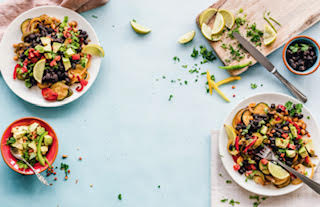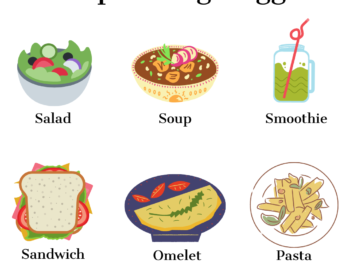Rightsize your Plate and your Waist: Portion control for the New Year.
Practicing portion control is one of the most difficult tasks facing anyone who eats out or even eats in these days. Look around you and everything is supersized. And not just fast food. Bagels, muffins, steaks, even frozen dinners have grown in size. I tracked the history of portion sizes increasing since the 20th century and found that portions are much much bigger than they were in the past, 2-5 times bigger to be exact. And so are people! No surprise. As I wrote in The Portion Teller Plan and in numerous articles, large portions contribute to weight gain because large portions contain more calories than small portions. Simple as it sounds, so many clients that I counsel don’t seem to apply logic to the equation. We know that if a 64-oz double Gulp soda is eight times bigger than a standard 100 calorie 8-oz soda, it should contain 8 times the calories. Yes, the Double Gulp contains 800 calories. Simple math? Yes. But… if WE drink it, we think, how can a soda possibly have so many calories?
Our plates have increased, so have our mugs, glasses, and wine goblets. Our cabinets and dishwashers are now larger to accommodate our satellite-sized dishes. And, car seats for our kids, who are now pudgier than ever, have also increased. And even caskets have become supersized!
Many of us don’t understand what a healthy portion is, and for good reason. A pasta portion in a restaurant is easily 3 cups, and many steaks are at least a pound. That is much too much food. The problem is that we’ve gotten used to these jumbo portion sizes and we think that a “portion” is whatever is put in front of us.
Getting used to normal-sized portions is not an easy task. Here are some tips:
Practice plate control. For starters, try eating off of plates your grandmother used. Next, change your expectation. Restaurants are in business to sell food, and lots of it. It is time to shift our perspective on what a reasonable amount of food is. If you use a smaller plate, you will probably begin to scale back on your portion.
Fill up on fruits and veggies. We want to scale back on our meat and potato portions and increase our intake of veggies. An easy trick is to fill half your plate with veggies. One quarter of your plate protein (meat, fish, poultry, tofu) and one quarter healthy starch (brown rice, quinoa, barley).
Buy single-servings when possible. Steer clear of the jumbo bags of chips, cookies, and nuts sold at price warehouse clubs such as Costco. We all love a good bargain, but beware when it comes to buying food. While you may want to stock up on toilet paper or paper towels, when it comes to food, buy smaller servings. Single-serve bags of chips will really help you practice portion control while snacking.
Order a small. In many cases you have a choice between a small, medium, or large. Order the small size whenever possible.
Avoid your triggers. If you can’t stop at one serving of chips, then don’t even start. Choose a treat you CAN control.
Don’t snack out of the bag. Familiarize yourself with the serving size on the food label, pour yourself one serving, and put the bag away. Practice this for chips, nuts, pretzels and other treats.
Don’t be fooled by health halos. Just because a food is labeled organic or trans fat free doesn’t mean you can eat as much as you want. Calories are still calories.
Skip all-you-can-eat buffets. They may be a bargain for your pocketbook, but not for your health. If you must visit a buffet, do a full lap around the buffet before choosing your selection and wear tight fitting clothes (you’ll probably eat less.)
Share, share, and share. Restaurant portion sizes are huge. Order one main dish and an extra veggie dish or salad and share both. And order one dessert for two or three people and you will still feel satisfied.
Eat like a Parisian. Eat slowly, savor your food, and enjoy your company.
Enjoy! Bon Appetit.



